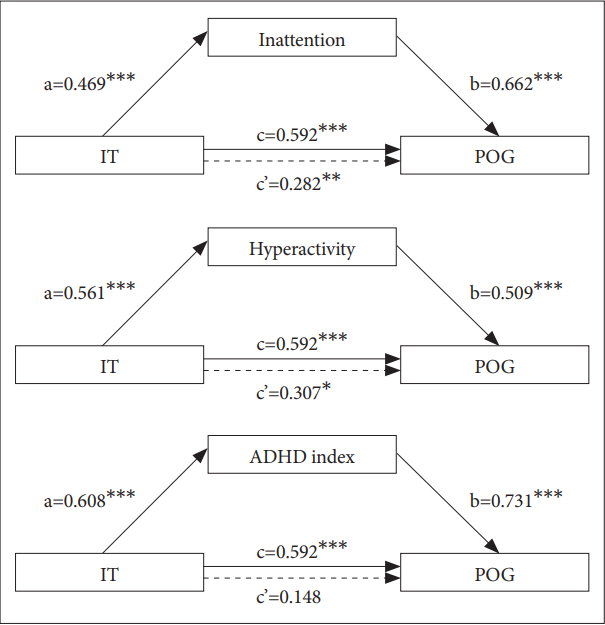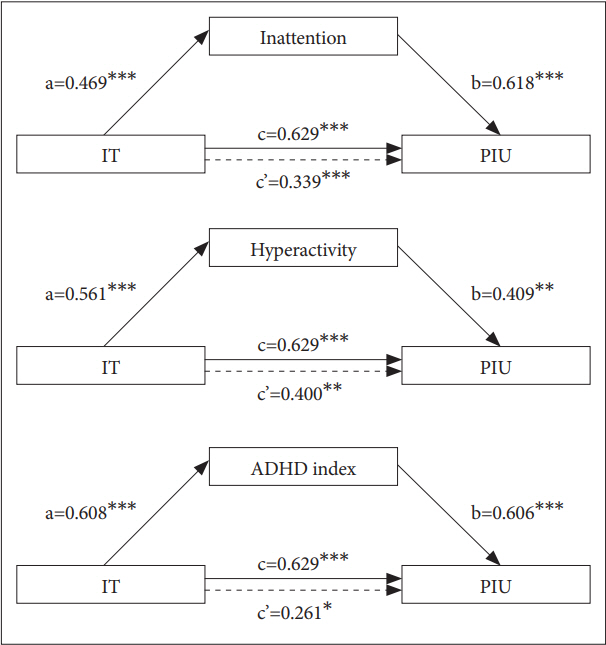1. American Psychiatric Association. Diagnostic and Statistical Manual of Mental Disorders (5th Ed.). Arlington, VA: American Psychiatric Publishing; 2013.
2. Petry NM, Rehbein F, Gentile DA, Lemmens JS, Rumpf HJ, Mossle T, et al. An international consensus for assessing internet gaming disorder using the new DSM-5 approach. Addiction 2014;109:1399-1406.


3. Starcevic V. Is Internet addiction a useful concept? Aust N Z J Psychiatry 2013;47:16-19.


4. Griffiths MD, Davies MN, Chappell D. Demographic factors and playing variables in online computer gaming. Cyberpsychol Behav 2004;7:479-487.


6. Park MH, Park EJ, Choi J, Chai S, Lee JH, Lee C, et al. Preliminary study of Internet addiction and cognitive function in adolescents based on IQ tests. Psychiatry Res 2011;190:275-281.


8. Ko CH, Yen JY, Chen CC, Chen SH, Yen CF. Gender differences and related factors affecting online gaming addiction among Taiwanese adolescents. J Nerv Ment Dis 2005;193:273-277.


9. Hyun GJ, Han DH, Lee YS, Kang KD, Yoo SK, Chung US, et al. Risk factors associated with online game addiction: A hierarchical model. Comput Hum Behav 2015;48:706-713.

11. Ko CH, Yen JY, Chen CS, Chen CC, Yen CF. Psychiatric comorbidity of internet addiction in college students: an interview study. CNS Spectr 2008;13:147-153.


12. Carli V, Durkee T, Wasserman D, Hadlaczky G, Despalins R, Kramarz E, et al. The association between pathological internet use and comorbid psychopathology: a systematic review. Psychopathology 2013;46:1-13.


13. Strittmatter E, Kaess M, Parzer P, Fischer G, Carli V, Hoven CW, et al. Pathological Internet use among adolescents: Comparing gamers and non-gamers. Psychiatry Res 2015;228:128-135.


14. Hsu SH, Wen MH, Wu MC. Exploring user experiences as predictors of MMORPG addiction. Comput Educ 2009;53:990-999.

15. Lehenbauer-Baum M, Fohringer M. Towards classification criteria for internet gaming disorder: Debunking differences between addiction and high engagement in a German sample of World of Warcraft players. Comput Hum Behav 2015;45:345-351.

16. Young KS, Rodgers RC. The relationship between depression and Internet addiction. Cyberpsychol Behav 1998;1:25-28.

17. Chang JS, Kim EY, Jung D, Jeong SH, Kim Y, Roh MS, et al. Altered cardiorespiratory coupling in young male adults with excessive online gaming. Biol Psychol 2015;110:159-166.


18. Montgomery SA, Asberg M. A new depression scale designed to be sensitive to change. Br J Psychiatry 1979;134:382-389.


19. Witmer BG, Singer MJ. Measuring presence in virtual environments: a presence questionnaire. Presence Teleop Virt 1998;7:225-240.

20. Promotion KAfDO. A Study of the Development of Internet Game Addiction Scale for Children and Adolescents. Seoul: KADO; 2006.
21. Young KS. Caught in the Net: How to Recognize the Signs of Internet AddictionŌĆöAnd a Winning Strategy for Recovery. New York, NY: JohnWiley & Sons; 1998.
22. Kim D. The Follow Up Study of Internet Addiction Proneness Scale. Seoul: Korea Agency for Digital Opportunity and Promotion; 2008.
23. Conners CK, Erhardt D, Sparrow EP. ConnersŌĆÖ Adult ADHD Rating Scales: Technical Manual. New York, NY: Multi-Health Systems; 1999.
24. Ward MF, Wender PH, Reimherr FW. The Wender Utah Rating Scale: an aid in the retrospective diagnosis of childhood attention deficit hyperactivity disorder. Am J Psychiatry 1993;150:885-890.


26. Sobel ME. Asymptotic confidence intervals for indirect effects in structural equation models. Sociol Methodol 1982;13:290-312.

29. Yee N. Motivations for play in online games. Cyberpsychol Behav 2006;9:772-775.


30. Caplan S, Williams D, Yee N. Problematic Internet use and psychosocial well-being among MMO players. Comput Hum Behav 2009;25:1312-1319.

31. Lehenbauer-Baum M, Klaps A, Kovacovsky Z, Witzmann K, Zahlbruckner R, Stetina BU. Addiction and engagement: an explorative study toward classification criteria for internet gaming disorder. Cyberpsychol Behav Soc Netw 2015;18:343-349.


32. Weibel D, Wissmath B. Immersion in computer games: the role of spatial presence and flow. Int J Comput Games Technol 2011;1-14.


33. Blum K, Chen AL, Braverman ER, Comings DE, Chen TJ, Arcuri V, et al. Attention-deficit-hyperactivity disorder and reward deficiency syndrome. Neuropsychiatr Dis Treat 2008;4:893-918.


36. Han DH, Lee YS, Na C, Ahn JY, Chung US, Daniels MA, et al. The effect of methylphenidate on Internet video game play in children with attention-deficit/hyperactivity disorder. Compr Psychiatry 2009;50:251-256.


37. Haagsma MC, Pieterse ME, Peters O. The prevalence of problematic video gamers in the Netherlands. Cyberpsychol Behav Soc Netw 2012;15:162-168.













